November 6, 2022 Addendum: I originally published this review of the Ghostwriter markdown editor on October 8, 2021. In September or October 2022, Ghostwriter was acquired by KDE. It had originally been maintained by its creator, wereturtle. I have been using Ghostwriter continuously since I wrote the review and my original impressions of it are unchanged from that time. Moreover, I have not noticed any changes since Ghostwriter joined the KDE family. I have updated the post where appropriate to reflect that Ghostwriter is now a KDE application, but my review remains otherwise substantively unchanged from its original publication.
Introduction
I have referenced the Ghostwriter markdown editor on a couple of occasions here at The New Leaf Journal. The first was when I described going through some pains to install it after I reinstalled Manjaro (a Linux-based operating system) on my computer. The second was when I described my efforts to set up Ghostwriter on Victor V. Gurbo’s 2007 MacBook running Bodhi Linux. On both occasions, I noted that I draft all of my New Leaf Journal content in Ghostwriter. Because it is my single favorite writing tool, I decided to share why I like it with the good readers of The New Leaf Journal. Those of you who are inclined to try it will find links to the relevant installation instructions.
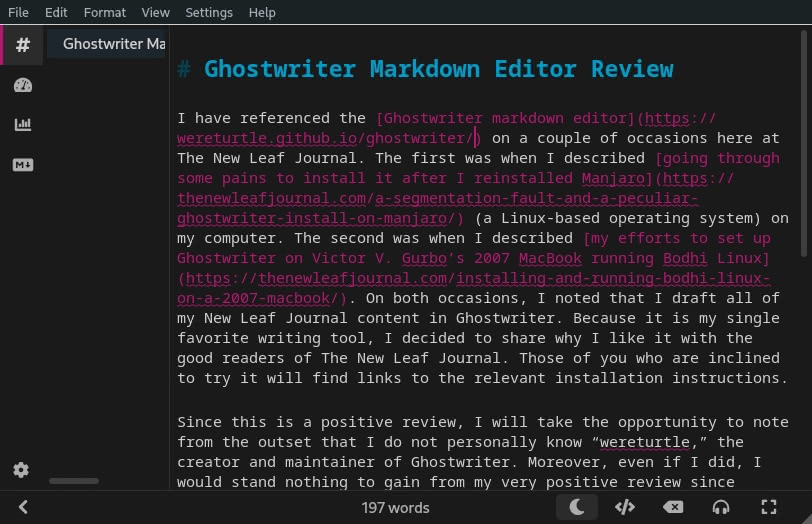
The following review is based on my own impressions of Ghostwriter and is entirely unsolicited. Ghostwriter is free and open source and free of cost to download and use.
What is Markdown and What is a Markdown Editor?
Let us start from the basics.
Ghostwriter is a markdown editor. Markdown is a simple and lightweight markup language that was created in 2004 by Mr. John Gruber and Mr. Aaron Swartz. Mr. Gruber described the purpose of markdown in an essay published on December 17, 2004:
The overriding design goal for Markdown’s formatting syntax is to make it as readable as possible. The idea is that a Markdown-formatted document should be publishable as-is, as plain text, without looking like it’s been marked up with tags or formatting instructions. While Markdown’s syntax has been influenced by several existing text-to-HTML filters, the single biggest source of inspiration for Markdown’s syntax is the format of plain text email.
While my impression is that markdown is most used in programming and developing circles, Wikipedia notes that “[m]arkdown is widely used in blogging, instant messaging, online forms, collaborative software, documentation pages, and readme files.” The Editor of The New Leaf Journal submits that it is also amenable to use for writing long-form articles with multi-tiered headings (including this one) and legal documents.
Ghostwriter itself includes a built-in markdown cheat-sheet, so I will refrain from writing a markdown guide.
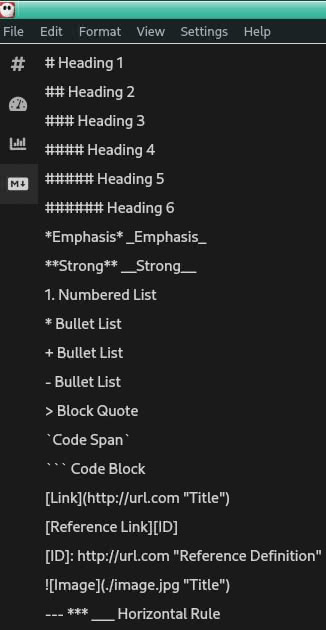
However, for those of you who may not be familiar with the most common markdown syntax, I submit three very good introductions below:
There are many markdown editors available for Windows, Mac, Linux, Android, and iOS. Furthermore, there are many applications (especially in the note-taking area) that support markdown (e.g., Joplin). In this sense, Ghostwriter is not unique. It is, however, my favorite application for writing. For those who are interested, you can see a list of alternatives to Ghostwriter for an idea of what is available.
About Ghostwriter
Ghostwriter is a free and fully open source markdown editor created by wereturtle. As of September or October 2022, it became a KDE application. The developer explains why he created Ghostwriter on the application’s official website (note: archived version of the original website):
Over the years, I have greatly benefitted from free and open source software. I want to give something back to the community. As such, I have distributed this software under the generous GNU General Public License v3.0. Enjoy!
“wereturtle”
If you follow the link to the archived homepage for his website, you will note that he formatted the link to Ghostwriter’s license in markdown. Since I am drafting this article in Ghostwriter, that was quite convenient.
The Ghostwriter source code, like the Ghostwriter website, is hosted on GitHub.
Ghostwriter’s aesthetically pleasing website lists the key features of the editor with screenshots to illustrate said features. While the creator of the application has an interest in presenting it in an appealing way, I can attest from having used Ghostwriter as my primary writing tool for nearly all of 2021 that the website provides an excellent overview of what Ghostwriter offers.
Why I Like Ghostwriter
Like most markdown editors, Ghostwriter offers a clean and relatively minimalist user-interface for writing. Of the markdown editors that I have seen and dabbled in, Ghostwriter employs my favorite user interface.
Ghostwriter is a Writer-Friendly Markdown Application
In recent versions, Ghostwriter added an optional left sidebar (it can be toggled on and off) that includes headers (which makes it possible to jump from one header to another), writing speed, word count, readability, and the markdown cheat-sheet, along with related statistics. For the work I do, two of those tabs are very useful. The ability to easily move from one header to another is a welcome feature for my long-form articles and legal documents. For New Leaf Journal purposes, having quick access to word count statistics is helpful because I try to manage the length of sections between headers. .
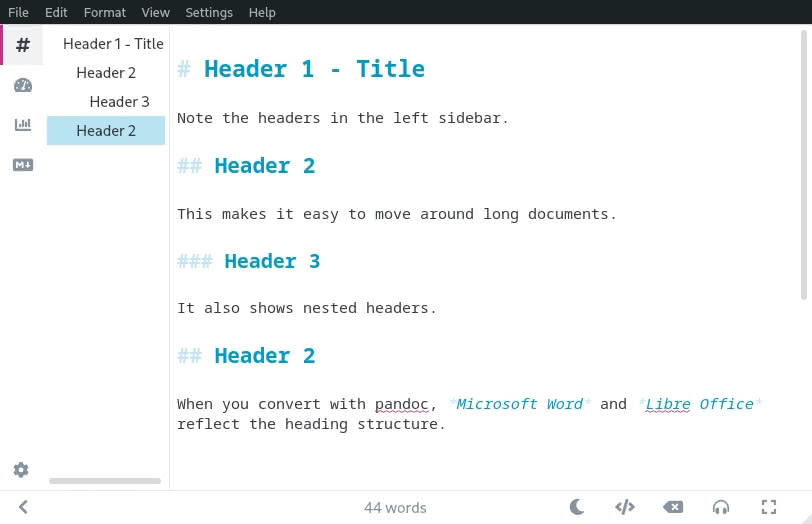
Ghostwriter’s theming is also a nice feature, albeit one I have not yet taken full advantage of. Ghostwriter comes with two excellent themes out of the box, and the ability to toggle dark mode on or off with the press of a button under the writing area effectively doubles those two themes. However, as you will see in the below screenshot, Ghostwriter gives users fine-grained controls to create their own color themes. The worst abominations of the imagination are thus made possible.
One feature that I enjoy is easy find-and-replace functionality. It is not uncommon for me, when dealing with an immigration law document featuring foreign names, to discover halfway through what I am writing that I have misspelled a name 15 times. By pressing ctrl + h, I can summon a find and replace feature to replace all of the misspellings in one swoop.
Finally, Ghostwriter includes an HTML preview pane. In effect, this shows what the markdown text will look like when it is converted into HTML, which is what one would expect to view on a website or in a document. When I first started working in markdown, I found this feature useful if I was unsure about one syntax or another. Although I seldom use it now, it is a good way to catch mistakes – since syntax errors in markdown are more obvious when in the preview pane.
For these reasons, Ghostwriter is very friendly to writers, whether professional, creative, or casual . It includes the essential (for most normal cases) trappings of a dedicated word processor like Microsoft Word or Libre Office, but with the benefit of being able to work in markdown in a much neater environment.
That brings us to another essential feature.
Document Conversion With Pandoc
Few writers publish work that displays in raw markdown. While raw markdown is perfectly readable, it is not an aesthetic format for reading creative writing pieces or other forms of writing designed for general reading.
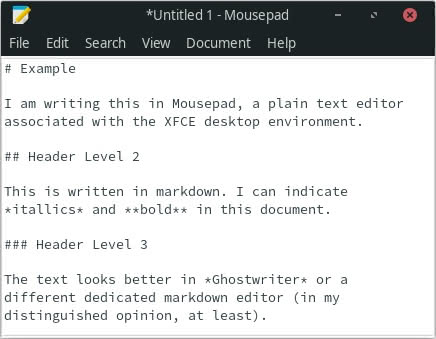
Some applications and platforms convert markdown into HTML without any in-between. For example, I use Buttondown to manage and send our official newsletter, The Newsletter Leaf Journal (sign-up via email or RSS here). When I started using Buttondown, it only provided for markdown and plain text. That was my initial impetus to learn to use markdown. (It now allows for rich text as well.)
However, other platforms do not convert markdown on their own. One sad example for me is WordPress, which we use for The New Leaf Journal. In addition to my New Leaf Journal work, I can hardly submit legal briefs, memoranda, research and drafts of other legal documents in pure markdown.
For these reasons, it is important to be able to convert markdown into other formats when the need arises. Ghostwriter provides several means for document conversion.
By default, Ghostwriter is built with cmark-gfm, which allows for exporting markdown into HTML. However, Ghostwriter can also export documents with MultiMarkdown or Pandoc if they are installed on the user’s system. The big one for me is Pandoc. With the help of Pandoc, Ghostwriter perfectly exports markdown documents into .docx, .odt, and .rtf, making it a very practical tool for drafting documents in the most common formats. It also allows for instant conversion to .pdf, various .epub formats, and .LaTeX. The export menu can be summoned by pressing ctrl + e.
The other export formats have their own uses, and there is some overlap between them. However, I have only really used Pandoc – and from my experience, it handles its export tasks without error.
A Pandoc Note
November 2022 Update: I no longer have this issue with Pandoc, but I will keep the passage for historical purposes in case it comes up in the future.
I will note that I have occasionally had issues with Pandoc on my Linux computers running distributions based on Arch and Ubuntu. For whatever reason, Ghostwriter is sometimes unable to locate Pandoc and include it as an export option. On these rare occasions, I have found that reinstalling Ghostwriter or Pandoc usually fixes the problem. In the end, I do not recall any situation where I was actually unable to export a document when I wanted to – but it does occasionally require fiddling. These experiences may vary depending on the system.
Autosave
By default, Ghostwriter automatically creates backups of documents while the user is working. This feature has come in handy for me on a couple of occasions.
Other Features
Ghostwriter has several additional features that I do not use in my work, but others may find helpful.
- Hemingway Mode: Ghostwriter can recreate the experience of working with a typewriter. Hemingway Mode disables the backspace and delete buttons. I never felt compelled to turn this on, but it may be a welcome feature for those looking for a pure distraction free experience or those who are nostalgic for the pre-word processor days.
- Focus Mode: Focus Mode grays out text except for the text that the user is currently working with. I was not aware of this feature until I read the official website in detail. It is not one that I expect to make use of, but it may help others with their writing.
- Math Jax: With the help of Math Jax, Ghostwriter can format equations in an aesthetic way. I almost wish that I had cause to write equations to try it – but alas, I do not.
- Drag and Drop Images: Ghostwriter creates local file-path URLs for images from the user’s file system that are dragged and dropped into a document. This feature has its uses, but it is not one that I have need for. .
- Ghostwriter can be used to create and manage task and to-do lists. Pressing ctrl + t creates a checklist. I have not used Ghostwriter for this purpose to date, but I may make use of it in the future. If one combines Ghostwriter with a good cloud storage solution or Syncthing, it could function as a good task-tracker in its own right.
- November 2022 Update. KDE’s Readme for Ghostwriter includes instructions for using it in the terminal. I do not regularly use the terminal for text editing, and when I do, I use Nano.
Endearing Logo/Mascot
Last, not lest, but definitely most importantly, Ghostwriter has the best logo/mascot of any markdown editor. Look at this guy.

We here at The New Leaf Journal always credit endearing macots.
Linux-First, Mixed Support for Windows and Mac
Updated on November 6, 2022: Ghostwriter was originally developed for Linux and is most readily available for Linux systems. It had more limited support for Windows and MacOS. This is still the case. However, KDE now states on the Ghostwriter Readme that it will make available binary versions of Ghostwriter for Windows and MacOS in the future. I have substantially updated all of the items in this section and added a new sub-section for BSD.
Linux
Updated on November 6, 2022, to reflect that my main computer now runs EndeavourOS instead of Manjaro.
All of my computers run Linux, so I have no issue with Ghostwriter’s availability. The official website notes that there are Ghostwriter packages for Ubuntu and Fedora. I have added the repository on Ubuntu-based systems, including one on a 2007 MacBook, and installed Ghostwriter with no issue.
(For those of you running Ubuntu 18.04 or a derivative, I note that the version of Pandoc in the official repositories for Ubuntu 18.04 and its derivatives is out-of-date, and I was not able to use that version of Pandoc with the new version of Ghostwriter. I have had no issue with Ghostwriter and Pandoc on Linux Lite or Bodhi Linux, which are both based on Ubuntu 20.04.)
My main computer runs EndeavourOS, which is based on Arch Linux. Although the Ghostwriter website does not list an Arch package, there is an Arch package for Ghostwriter and it works without any issues. When I wrote this review in 2021, I was using Manjaro Linux, which, like EndeavourOS, is based on Arch, but is a bit more distant from the parent. I had been using the Manjaro community version of Ghostwriter — which is what this review was based on.
Below, you will see three versions of Ghostwriter available in the Manjaro Linux graphical package manager as of October 2021.
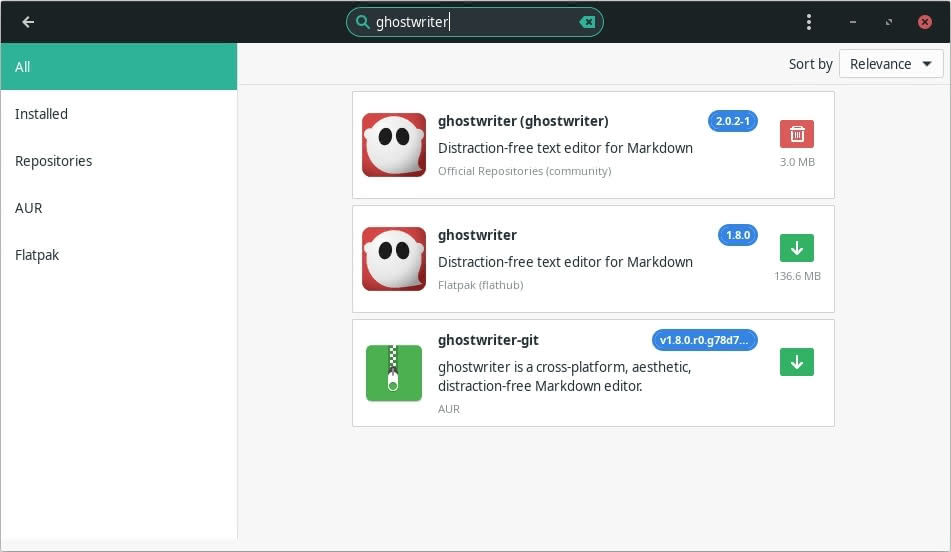
There is also a Ghostwriter Flatpak. It was very out-of-date when I wrote this review. It is currently up-to-date and available in Flathub. However, the GitHub repository for Ghostwriter is still (as of November 2022) under the ownership of wereturtle, and the KDE docs make no reference to the Flatpak. I would generally recommend using your Linux distribution’s package for Ghostwriter if available, but so long as it is maintained, the Flatpak may be a good alternative.
Windows and MacOS
Update for November 2022: As I noted above, KDE states that it will release Windows and MacOS binaries for Ghostwriter in the future. At the moment, the GitHub repository for Ghostwriter contains instructions for building it on Windows and MacOS. I have removed the original section that I wrote here since it appears to be superseded by KDE’s acquisition of Ghostwriter.
BSD
Update: I added this section in November 2022.
KDE’s GitHub repository for Ghostwriter includes instructions for building the application on BSD. I assume that most people who are running BSD as a desktop operating system should have no trouble following the instructions to build it on their systems. Because I do not use BSD, I am not sure whether Ghostwriter may be packaged for some distributions.
Alternatives to Ghostwriter
While Ghostwriter is my favorite markdown editor, it is not the only markdown editor. There are many markdown editors available for Windows, MacOS, and Linux. Some, like Ghostwriter, are conducive to long-form writing. Others, like Joplin, are note-taking applications with markdown support. As of October 6, 2021, AlternativeTo lists 112 alternatives to Ghostwriter. The list may be especially interesting to Windows and MacOS users for whom Ghostwriter would not work for at this time.
I have three additional recommendations for readers to consider that provide slightly different markdown-editor features.
- Zettlr: A markdown editor that is geared toward research and academic writing. For non-academic purposes, its ability to work with file directories is very useful. It is available for Windows, MacOS, and Linux.
- Pepys: A markdown journal/diary application. I only just started using it but have been very impressed thus far. It is currently available for Windows and Linux.
- Markor: A terrific and powerful markdown application for Android devices with some built-in conversion functionality. I would use it more often if I could type on touchscreens without a separate keyboard.
Those are just three of many free and open source multi-platform markdown editors available.
Conclusion
I have used Ghostwriter as my primary writing tool for more than a year. In that time, it has become an essential part of my workflow. I encourage you to try it in combination with Pandoc to test it as a central tool for drafting all kinds of documents.
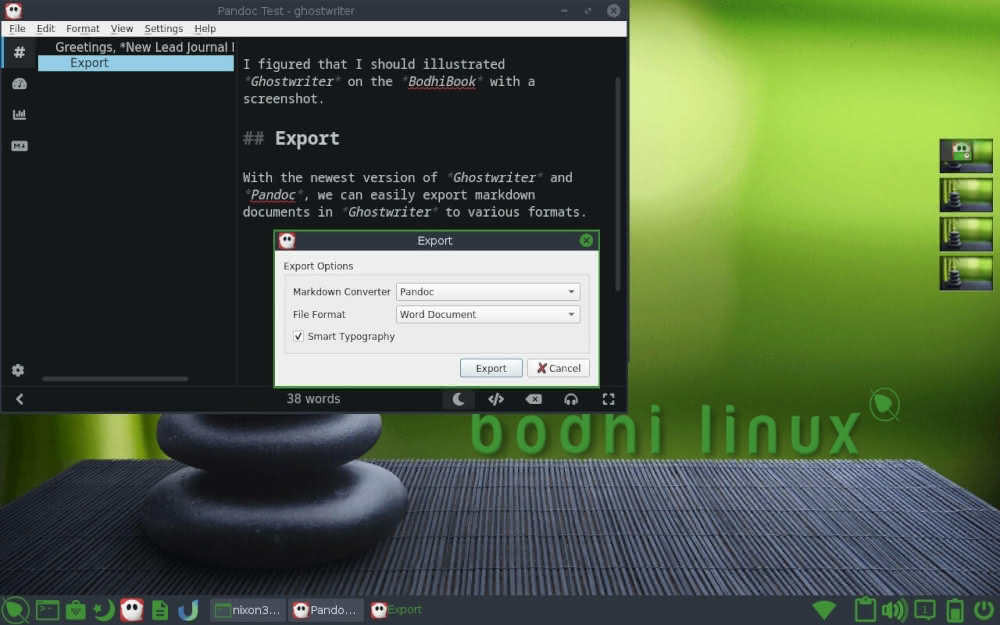
I thank Ghostwriter’s original creator, wereturtle, for making this terrific free and open source markdown editor available to the public. I look forward to seeing Ghostwriter become more readily available to a broader audience, including non-Linux users, under KDE’s stewardship.